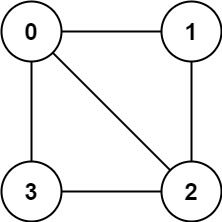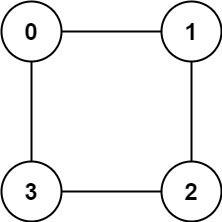LeetCode 785. Is Graph Bipartite【DFS,二分图】中等
本文属于「征服LeetCode」系列文章之一,这一系列正式开始于2021/08/12。由于LeetCode上部分题目有锁,本系列将至少持续到刷完所有无锁题之日为止;由于LeetCode还在不断地创建新题,本系列的终止日期可能是永远。在这一系列刷题文章中,我不仅会讲解多种解题思路及其优化,还会用多种编程语言实现题解,涉及到通用解法时更将归纳总结出相应的算法模板。
为了方便在PC上运行调试、分享代码文件,我还建立了相关的仓库:https://github.com/memcpy0/LeetCode-Conquest。在这一仓库中,你不仅可以看到LeetCode原题链接、题解代码、题解文章链接、同类题目归纳、通用解法总结等,还可以看到原题出现频率和相关企业等重要信息。如果有其他优选题解,还可以一同分享给他人。
由于本系列文章的内容随时可能发生更新变动,欢迎关注和收藏征服LeetCode系列文章目录一文以作备忘。
There is an undirected graph with n nodes, where each node is numbered between 0 and n - 1. You are given a 2D array graph, where graph[u] is an array of nodes that node u is adjacent to. More formally, for each v in graph[u], there is an undirected edge between node u and node v. The graph has the following properties:
- There are no self-edges (
graph[u]does not containu). - There are no parallel edges (
graph[u]does not contain duplicate values). - If
vis ingraph[u], thenuis ingraph[v](the graph is undirected). - The graph may not be connected, meaning there may be two nodes
uandvsuch that there is no path between them.
A graph is bipartite if the nodes can be partitioned into two independent sets A and B such that every edge in the graph connects a node in set A and a node in set B.
Return true if and only if it is bipartite.
Input: graph = [[1,2,3],[0,2],[0,1,3],[0,2]]
Output: false
Explanation: There is no way to partition the nodes into two independent sets such that every edge connects a node in one and a node in the other.
Input: graph = [[1,3],[0,2],[1,3],[0,2]]
Output: true
Explanation: We can partition the nodes into two sets: {0, 2} and {1, 3}.
Constraints:
graph.length == n1 <= n <= 1000 <= graph[u].length < n0 <= graph[u][i] <= n - 1graph[u]does not containu.- All the values of
graph[u]are unique. - If
graph[u]containsv, thengraph[v]containsu.
题意:存在一个 无向图 ,图中有 n 个节点。其中每个节点都有一个介于 0 到 n - 1 之间的唯一编号。给你一个二维数组 graph ,其中 graph[u] 是一个节点数组,由节点 u 的邻接节点组成。形式上,对于 graph[u] 中的每个 v ,都存在一条位于节点 u 和节点 v 之间的无向边。该无向图同时具有以下属性:
- 不存在自环(
graph[u]不包含u)。 - 不存在平行边(
graph[u]不包含重复值)。 - 如果
v在graph[u]内,那么u也应该在graph[v]内(该图是无向图) - 这个图可能不是连通图,也就是说两个节点
u和v之间可能不存在一条连通彼此的路径。
二分图 定义:如果能将一个图的节点集合分割成两个独立的子集 A 和 B ,并使图中的每一条边的两个节点一个来自 A 集合,一个来自 B 集合,就将这个图称为 二分图 。
如果图是二分图,返回 true ;否则,返回 false 。
解法 DFS染色判断二分图
二分图的节点可以分成两个集合,集合内的点之间没有边,任意一条边的两个节点属于不同集合,可以为图中各个节点着色,两个集合的节点分别涂成两种颜色。如果图中任何一条边的两个节点都可以被涂成不同的颜色,则该图就为二分图。
一个图可能包含多个子图,需要逐次对每个子图涂色。需要一个数组 colors 标记所有节点的颜色,规定 0 0 0 表示当前未涂色, 1 1 1 表示第一种颜色, 2 2 2 表示第二种颜色。为了给所有的节点着色,需要遍历图内的所有结点,在着色的过程中若碰到「已着色、但不符合一条边两个节点不同颜色」的情况,即可判断该图不可能是二分图。
遍历图的所有结点可以使用两种方式,即广度优先搜索和深度优先搜索。这里用DFS,比较简洁:
class Solution {
public:
bool isBipartite(vector<vector<int>>& graph) {
int n = graph.size();
vector<int> color(n);
function<bool(int, int)> dfs = [&](int i, int c) {
color[i] = c; // 1,2表示访问过,0表示未访问
for (int j : graph[i]) {
if (!color[j] && dfs(j, 3 - c) == false) return false;
else if (color[j] == color[i]) { return false; }
}
return true;
};
for (int i = 0; i < n; ++i)
if (!color[i] && dfs(i, 1) == false) return false;
return true;
}
};

